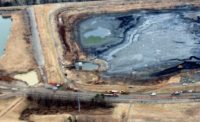Two environmental groups claim to have discovered evidence of coal-ash contamination in public areas adjacent to riverside storage sites slated for closure at a Richmond, Va.-area power plant.
Water and sediment tests conducted in July by the Southern Environmental Law Center (SELC) and the James River Association at Virginia Dominion Power’s 1,600-MW Chesterfield Power Station revealed high concentrations of zinc, nickel, copper and lead in boating and fishing areas located adjacent to the plant’s coal-ash storage ponds. The groups also claim to have found 292 milligrams per kilogram of arsenic in a sediment sample drawn from a publicly accessible location between the two ponds, estimated to contain at least 13 million tons of coal-ash residue.
The SELC said in a statement that the test results are “evidence that coal-ash toxins are leaking into the water” and called on the Virginia Dept. of Environmental Quality to impose stronger pollution safeguards before Dominion is allowed to proceed with closing the ponds at the 70-year-old power plant.
In June, the Virginia State Water Control Board released a draft permit to drain up to 5 million gallons of treated water daily from the ponds into the James River. A decision on issuing a final permit is expected in late September. Dominion also has proposed constructing an on-site lined landfill for future coal-ash disposal at the still-active plant.
Because the SELC’s test data were submitted following the comment period for the draft permit, they cannot be used in a final ruling, according to Virginia DEQ spokesman Bill Hayden. The agency’s own tests, also performed during July in the same areas, found no evidence of compromised water quality, he adds.
Hayden also says that it appears the SELC’s tests did not conform to the agency’s requirements
“Their testing method apparently measured ‘total recoverable metals,’ while the requirement is for ‘total dissolved metals,’ ” Hayden says. “We are continuing to seek additional information from SELC to determine if other action is appropriate.”
The SELC, which also opposes the proposed landfill’s location adjacent to the James River, previously has clashed with Dominion over alleged contamination from the utility’s 11 inactive coal-ash ponds, which are in various stages of closure to comply with the EPA’s 2015 Coal Combustion Residual Rules.
In 2014, the SELC filed a federal lawsuit against Dominion claiming Clean Water Act violations at a deactivated generating plant in Chesapeake. A ruling has yet to be handed down, although judges have rejected the utility’s requests to dismiss the case.
However, the adversaries also have shown a willingness to collaborate. Earlier this year, the SELC, Dominion and other groups reached agreement on the discharge of treated water from coal-ash ponds at two other deactivated Dominion power plants in Virginia. At both locations, the utility must implement additional wastewater-treatment measures should contaminant concentrations reach specific levels. Similar requirements are included in the draft permit for Dominion’s Chesterfield plant.


